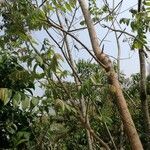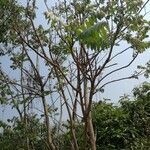Small trees, evergreen. Branchlets gray-brown, densely puberulent. Leaves crowded at apex of branches, 40-60 cm; petiole 7-13 cm; leaflets 6-13 pairs, opposite or nearly so; blades oblong-ovate, 7-13 × 4-6 cm, base obtuse-rounded, oblique, margin entire, apex shortly acuminate or obtuse-rounded; rachis puberulent. Panicles terminal, 20-40 cm, base of branches at different levels articulate. Flowers unisexual or polygamous, 1-3-fasciculate; subtending bracts small, deltoid; pedicel 1-2 mm. Calyx cup-shaped, puberulent, ca. 0.5 mm high, with 5 short and obtuse lobes. Petals 5, glabrous, 2-3 × ca. 1 mm. Stamens curved and folded, glabrous, 3-5 mm in buds of males, 1-3 mm in females; anthers ca. 0.8 mm, degenerate in female. Carpels 5, densely puberulent; styles connate, 0.5-1 mm high, ± puberulent; stigmas 5, free or only base slightly connate, 1-1.5 mm. Samarium 3-5 × 1-1.8 cm. Fr. Dec-Apr.


